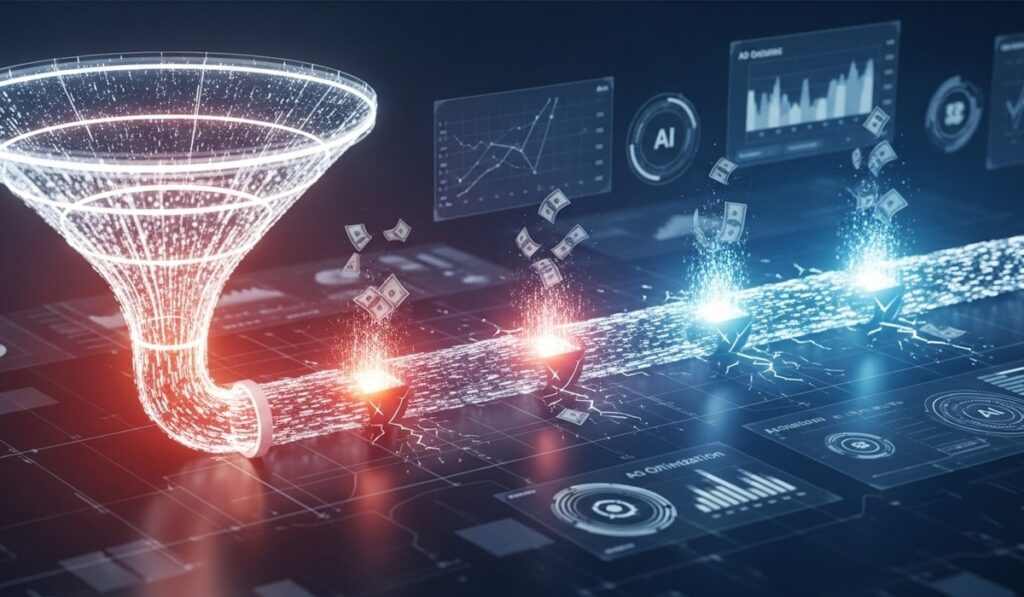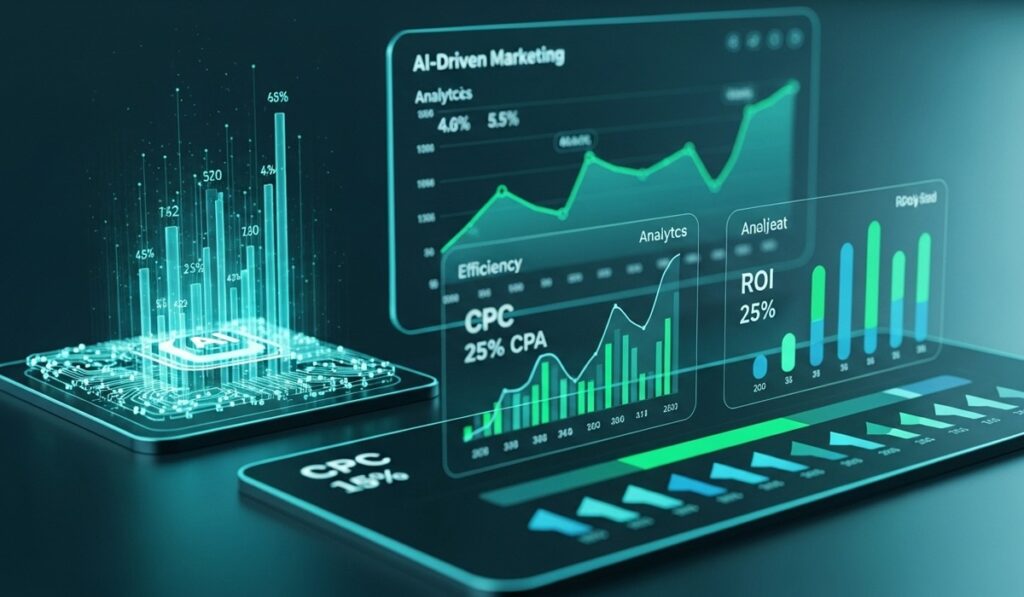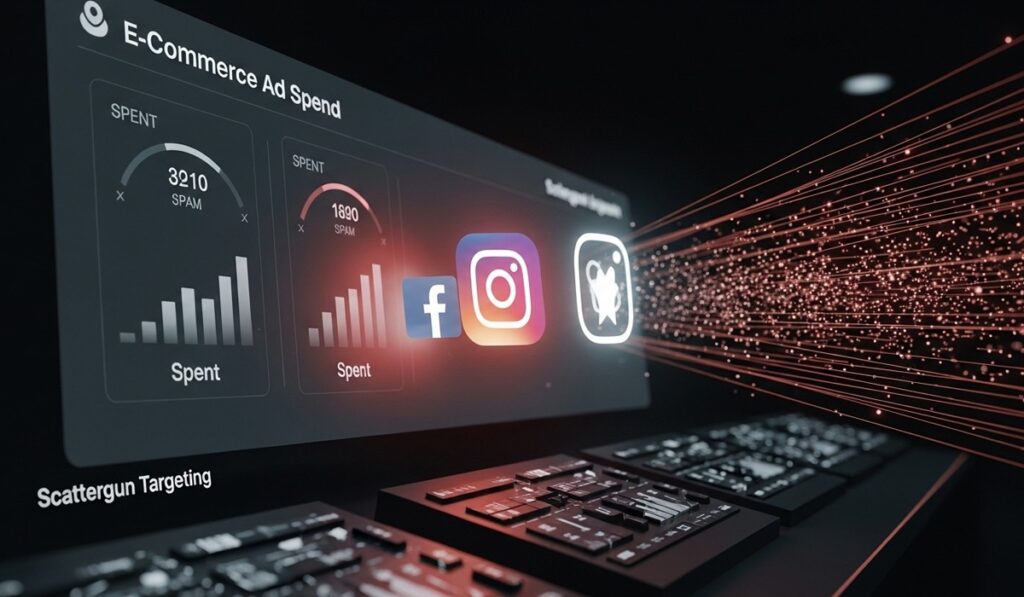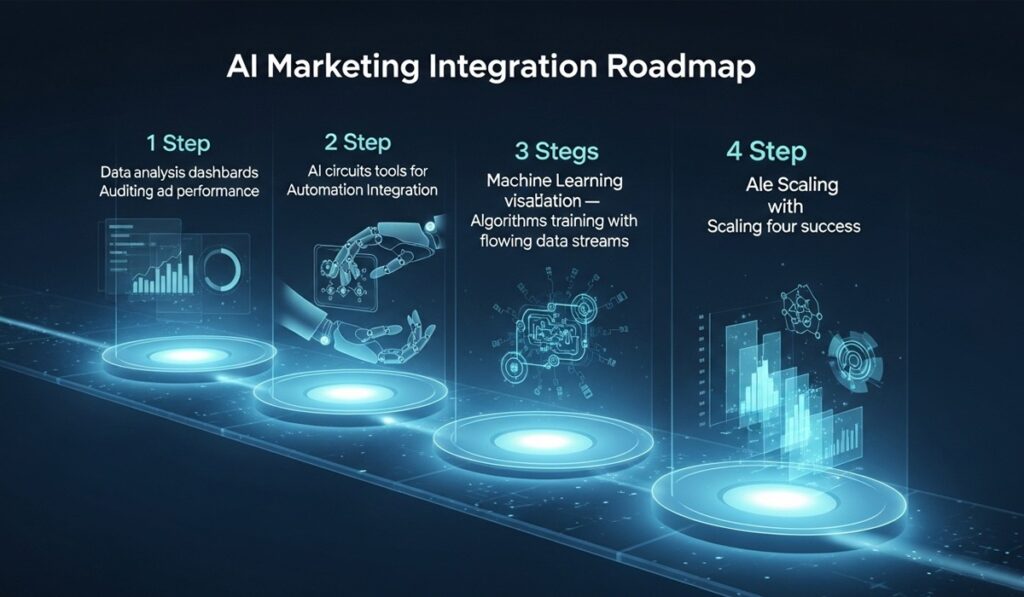Industry Trend: In late 2025, ad costs on Meta and Google are up another 15% year-over-year.
Our new analysis shows the average small business wastes over $5,000 a month on ads shown to the wrong people.
That money is vanishing without a return.
But a smart group of marketers is fighting back. They’re not spending more; they’re spending smarter.
Their secret weapon is AI optimization. This guide shows you exactly how they do it.
For those just starting out, our AI marketing guide for startups and agencies provides a great foundation.
Table of Contents
| Sections | Key Findings |
| Why Your Ad Spend Is Wasting Money | Manual targeting guesswork and slow optimization are the main causes of inefficient ad spend. |
| What Is AI Ad Optimization? | AI uses machine learning to automate targeting, bidding, and creative adjustments in real time. |
| Real Benefits of AI Optimization | The primary benefits are lower acquisition costs, higher conversion rates, and significant time savings. |
| Case Study: Cutting Ad Spend by 52% | A real-world scenario shows how AI can dramatically reduce costs while increasing results. |
| Top AI Tools for Ad Optimization | Specific AI tools are designed for creative generation, automated management, and bidding. |
| How to Start Cutting Ad Spend Today | A simple 4-step framework helps you integrate AI optimization into your current strategy. |
| Common Mistakes to Avoid with AI | Success requires a balance of AI automation and crucial human oversight. |
| Frequently Asked Questions | Get quick, concise answers to the most common questions about AI ad optimization. |
Why Your Current Ad Spend Is Wasting Money

Before we fix the problem, we need to understand where the leaks are. Most ad accounts are losing money in three predictable places.
Manual Targeting and Guesswork
For years, marketers have relied on audience personas and demographic assumptions.
We tell platforms like Facebook, “Show my ads to 25- to 35-year-old men who like hiking and live in Colorado.”
This is an educated guess at best. The reality is that your ideal customer profile is far more nuanced.
Manual targeting often misses thousands of potential high-intent buyers while wasting impressions on those who will never convert. It’s simple because they don’t fit a neat demographic box.
Poor Bidding and Budget Allocation
Manual bidding is a constant, exhausting balancing act. You set a daily budget and a maximum bid, then hope for the best.
But ad auctions are dynamic, with costs fluctuating by the minute based on competition and user behavior.
A bid that was cost-effective at 9 AM might be wildly overpriced by noon.
Without real-time adjustments, you’re either overpaying during expensive peak hours or missing out on conversions during cheaper off-peak times.
This leads to inefficient budget allocation where funds aren’t directed to the top-performing campaigns, audiences, or ads at the moment they’re most effective.
Lack of Real-Time Optimization
A creative that performed brilliantly last week can experience fatigue and a sudden drop in performance today.
Your competitor might launch a new campaign, driving up your costs unexpectedly.
A human marketer can’t possibly monitor every single variable across dozens of campaigns 24/7.
This delay means that by the time you spot a problem in a weekly report, the damage is already done, and the budget has been wasted.
What Is AI Ad Optimization (and How It Works)

AI ad optimization is like hiring a brilliant data scientist who works 24/7. It uses technology to make smarter, faster decisions than any human ever could.
Machine Learning in Ad Targeting
Instead of relying on broad demographic guesses, AI analyzes thousands of data points in real time.
It looks at browsing history, past purchases, on-site behavior, and lookalike signals to identify users who are most likely to convert right now.
This algorithmic approach finds hidden patterns and “micro-segments” that a human would never spot.
As a result, your ads are served to the highest-intent audience possible, dramatically reducing wasted impressions.
Predictive Budget Distribution
An AI-powered system can analyze historical performance data and market trends.
This ability can forecast which campaigns will deliver the best ROAS over the next hour, day, or week.
It then automatically reallocates your budget away from underperforming segments and toward these predicted winners.
The predictive power ensures your money is always working as hard as it possibly can.
Dynamic Creative Optimization (DCO)
Dynamic Creative Optimization is where AI gets truly personal.
Instead of showing everyone the same ad, DCO allows the AI to assemble the best possible ad for each individual user.
It can mix and match different headlines, images, calls-to-action, and descriptions based on that user’s specific data profile.
For someone who browses a specific product, the AI can serve an ad featuring that exact item.
This level of personalization leads to much higher engagement and conversion rates.
Real Benefits of AI Optimization for Ad Spend

The impact of AI shows up directly in your bank account. Here are the tangible results you can expect.
- Reduce Cost Per Click (CPC) and Cost Per Acquisition (CPA)
By showing ads only to the users most likely to be interested, AI eliminates wasted spend on low-intent clicks.
This surgical precision naturally lowers your average CPC.
More importantly, because the audience is highly qualified, more of those clicks turn into sales or leads.
This drives down your Cost Per Acquisition (CPA), the single most important metric for profitability.
“A 2025 analysis by Forrester found that businesses using AI for ad optimization saw an average CPA reduction of 28%.”
- Improve Conversion Rates Through Smart Segmentation
AI’s ability to identify and target niche audience segments is a game-changer for conversion rates.
It moves beyond broad demographics to find clusters of users who share specific behavioral traits.
By delivering tailored messaging and creatives to these micro-audiences, you create a more relevant and compelling ad experience.
This relevance translates directly into higher click-through rates and, ultimately, more conversions on your website.
- Save Time on Manual Analysis and Reporting
The average performance marketer spends nearly 10 hours a week just pulling reports, analyzing spreadsheets, and making manual campaign adjustments.
AI automates almost all of this tedious work. It handles the moment-to-moment bidding, budget shifts, and A/B testing, enabling your team to focus on high-level strategy, creative development, and understanding the customer.
Case Study – How One Brand Cut Ad Spend by 52% Using AI

Let’s look at a fictionalized but realistic scenario. This e-commerce brand was stuck in a cycle of high spend and low return before they turned to AI.
Background: E-commerce Brand Overspending on Facebook Ads
“Urban Bloom,” a direct-to-consumer brand selling sustainable home goods, was spending $20,000/month on Facebook and Instagram ads.
Their targeting was broad (e.g., “women 25-45 interested in eco-friendly products“), and their CPA was hovering around an unprofitable $75.
Problem: Inefficient Targeting and Poor Creative Testing
The marketing team was manually testing 3-4 ad variations per week.
But the winning creative was often determined by “gut feel” rather than data.
And their broad audience meant a huge portion of their budget was spent on users who had no purchase intent.
Solution: Introduced AI-based bidding + creative optimization
Urban Bloom integrated a third-party AI optimization tool. The AI began by analyzing their Pixel data to build a far more sophisticated profile of their ideal customer.
It also used DCO to test hundreds of creative combinations—
- Pairing different images generated with an AI Art Generator with various headlines and descriptions
- To find the perfect message for each audience micro-segment.
For video ads, they leveraged an AI Video Generator to quickly produce dozens of variations for testing.
Result: 52% Drop in Spend, 1.8x Increase in Conversions
Within 6 weeks, the results were staggering. The AI identified that their most profitable audience wasn’t just “eco-conscious women,” but specifically “apartment-dwelling female renters aged 28-36 who follow minimalist design influencers.”
So, they focused the budget here and served hyper-relevant creatives.
Their CPA dropped from $75 to $34. They were able to reduce their total ad spend to just $9,600/month.
4 Top AI Tools to Optimize Your Ads Efficiently
These powerful tools are accessible to startups and agencies right now, and they’re key to helping you boost ad results with AI tools.
- AdCreative.ai – Smart Creative Generation
This platform specializes in using AI to generate hundreds of high-performing ad creatives in minutes.
You provide your brand assets and messaging, and its algorithm creates visually compelling banners, social posts, and product ads tailored for different platforms.
- Revealbot – Automated Ad Management
Revealbot automates the tedious rule-setting and campaign management process on platforms like Facebook, Google, and TikTok.
You can set up complex “if-then” rules that allow the AI to automatically pause bad ads, scale good ones, and adjust budgets based on real-time performance metrics like ROAS or CPA.
- Albert.ai – Full-Funnel Campaign Optimization
Albert is a more holistic AI marketing platform that manages campaigns across search, social, and programmatic advertising.
It handles audience discovery and bidding to creative optimization and cross-channel budget allocation.
- Google Ads Smart Bidding – Built-in AI Advantage
You can’t overlook the powerful AI built directly into Google Ads.
Strategies like Target CPA, Target ROAS, and Maximize Conversions use Google’s own machine learning to optimize bids for every single auction.
When fed with accurate conversion data, it’s one of the most effective ways to improve performance on the search network.
And for generating the high-quality visuals these platforms need, you can try Pixi AI Art Generator. It can help you assemble them into polished ads.
Step-by-Step: How to Start Cutting Ad Spend with AI Today

You can begin your journey to efficiency in four manageable steps..
Step 1 – Audit Your Current Ad Performance
Dive into your ad accounts and identify your key metrics: CPA, ROAS, CPC, and conversion rate.
Find out your best and worst-performing campaigns, audiences, and creatives. This data will be the foundation you feed the AI.
Step 2 – Integrate AI Tools or Automation Scripts
You don’t need to hand over everything at once. Begin by activating Google’s Smart Bidding on a couple of your key campaigns.
Or, sign up for a trial of a tool like Revealbot to automate some basic rules, like pausing ads with a high CPA.
Step 3 – Test and Monitor for 30 Days
The most common mistake is intervening too early. Machine learning algorithms need time and data to learn what works.
Let your test campaigns run for at least 30 days to gather enough performance data to make statistically significant decisions.
Monitor progress, but resist the urge to make constant manual changes.
Step 4 – Scale the Winning Campaigns
After the testing period, analyze the results. Did the AI-managed campaigns outperform your manually managed ones?
If so, it’s time to scale your ads.
Gradually roll out the AI optimization strategy to more of your campaigns and allocate a larger portion of your budget to the AI-driven approach.
Common Mistakes to Avoid with AI Ad Optimization
AI is powerful, but it’s not magic. To get the best results, you need to avoid these common pitfalls that trip up new users.
Relying Fully on Automation Without Human Oversight
Don’t “set it and forget it.”
You need to monitor overall performance, check for anomalies, and ensure the AI’s actions align with your broader business goals.
The ideal approach is to understand how to combine AI and human creativity for better ads.
Not Feeding Enough Quality Data
AI is only as smart as the data it’s given.
If your conversion tracking is broken or you’re feeding it inaccurate data, the ad AI will make poor decisions.
Ensure your tracking pixels, conversion events, and CRM data are clean and accurate before you let the AI take the wheel.
Ignoring Creative Quality and Brand Messaging
AI can optimize the delivery of your ads, but it can’t fix a bad message. Your ad creative—the images, videos, and copy—is still the most important element.
Continue to invest in high-quality creative development and compelling brand messaging.
A great place to start is learning how to write the perfect script for AI video generation.
Frequently Asked Questions
How much does AI ad optimization cost?
Costs vary widely. Some tools, like Google’s Smart Bidding, are built-in and free to use.
Third-party platforms can range from a few hundred dollars a month for small businesses to many thousands for enterprise-level solutions.
Can AI work for small businesses with limited budgets?
Absolutely. In fact, AI is arguably a better alternative for small businesses that don’t have an expert in-house performance marketer team.
Will AI replace my job as a PPC manager?
No, it will evolve it. AI automates the repetitive, data-crunching tasks, allowing PPC managers to become strategists.
So, your role will shift from manual bidding to overseeing the AI, focusing on creative strategy, landing page optimization, and high-level campaign planning.
How much data does AI need to work effectively?
More is always better. As a general rule, an ad account should have at least 30-50 conversions per 30 days for an AI bidding algorithm to have enough data to make reliable decisions.
What’s the difference between AI agents and automation?
Automation follows pre-set rules (e.g., “If CPA is over $50, pause the ad”). AI agents use machine learning to make their own decisions and predictions.
It doesn’t just follow rules; it learns, adapts, and finds new opportunities that weren’t programmed in.
Final Thoughts – The Future of Advertising Is AI-Powered
The choice for modern marketers is simple. You can continue with the old way of guessing and wasting money, or you can embrace the future of efficiency.
AI-powered optimization offers a clear path to lower costs, higher conversions, and a smarter way of working.
It’s about achieving radical efficiency, eliminating waste, and ensuring every dollar you spend contributes directly to your bottom line.
Go for the ad optimization tools we’ve mentioned above, or feel free to try some new ones. Start small, test intelligently, and embrace the power of data.
The journey starts with a better creative tool. Check out the Pixi AI Marketing Tools suite to generate high-performance ad creatives at scale.
